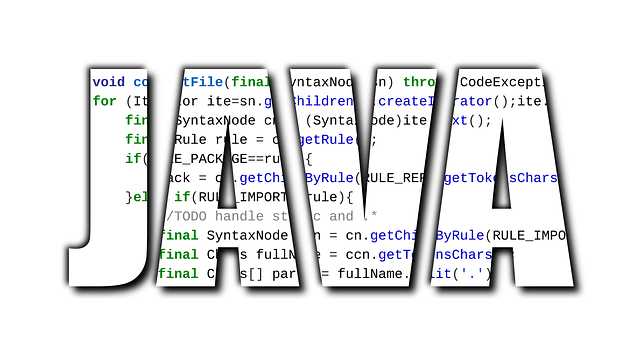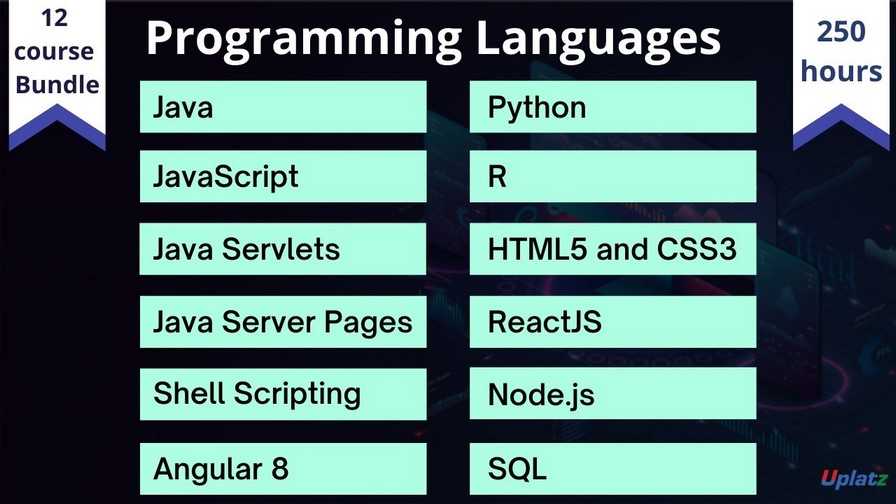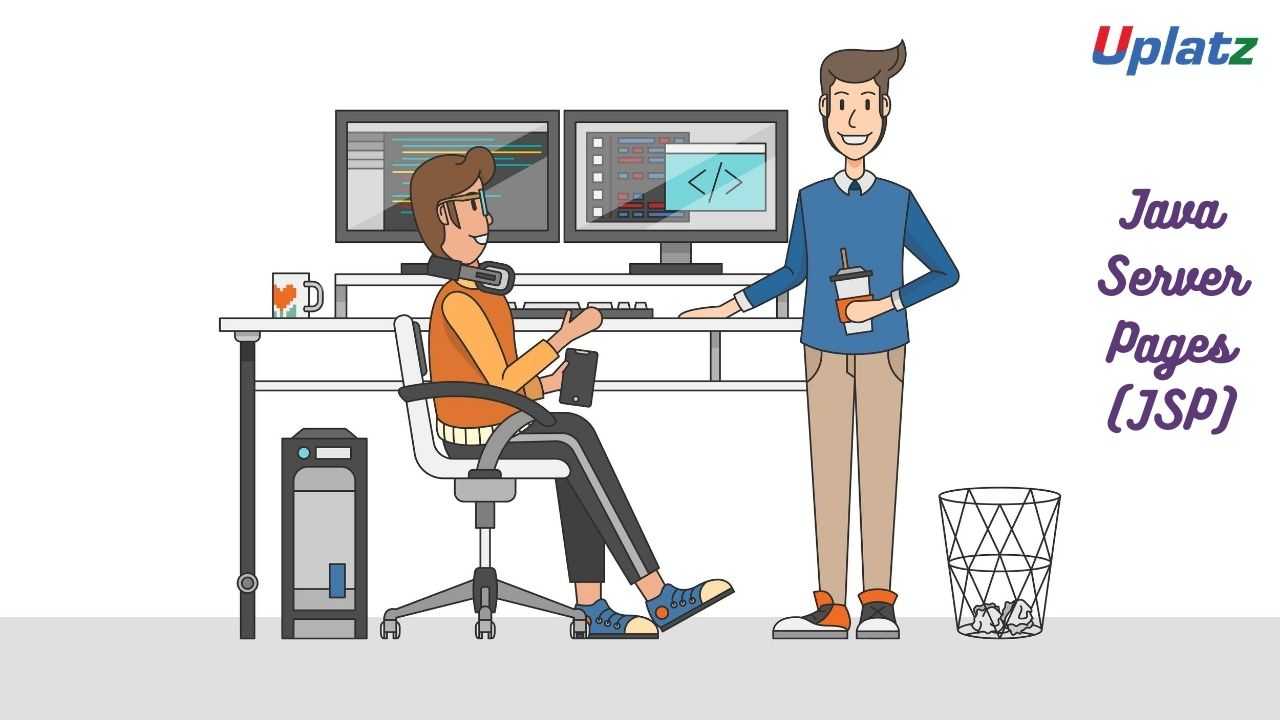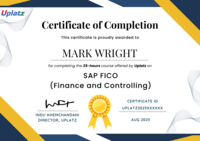Java Programming (advanced)
Learn Java classes, events, exceptions, mutations, design patterns, GUI components, mementos, hash codes, JUnit. Understand Java for Embedded Systems.Preview Java Programming (advanced) course
Price Match Guarantee Full Lifetime Access Access on any Device Technical Support Secure Checkout Course Completion Certificate 88% Started a new career
BUY THIS COURSE (
88% Started a new career
BUY THIS COURSE (GBP 12 GBP 29 )-
 80% Got a pay increase and promotion
80% Got a pay increase and promotion
Students also bought -
-

- Java Programming Basics
- 20 Hours
- GBP 12
- 2872 Learners
-

- Bundle Course - Programming Languages
- 250 Hours
- GBP 22
- 2454 Learners
-

- JSP (Java Server Pages)
- 15 Hours
- GBP 12
- 843 Learners

Java is an object-oriented programming language that may be used to create software that runs on a variety of platforms. When a programmer creates a Java application, the produced code (also known as bytecode) may operate on a wide range of operating systems, including Windows, Linux, and Mac OS.
Java is a powerful general-purpose programming language. It is used to develop desktop and mobile applications, big data processing, embedded systems, and so on. According to Oracle, the company that owns Java, Java runs on 3 billion devices worldwide, which makes Java one of the most popular programming languages. Java is a powerful general-purpose programming language. It is used to develop desktop and mobile applications, big data processing, embedded systems, and so on. According to Oracle, the company that owns Java, Java runs on 3 billion devices worldwide, which makes Java one of the most popular programming languages.
Popular for its versatility and ability to create a wide variety of applications, learning Java opens up your possibilities when coding. With it, you’ll be able to develop large systems, software, and mobile applications — and even create mobile apps for Android.
Advanced Java is everything that goes beyond Core Java – most importantly the APIs defined in Java Enterprise Edition, includes Servlet programming, Web Services, the Persistence API, etc. It is a Web & Enterprise application development platform which basically follows client & server architecture.
Key Features of Advanced Java
1) Advance Java i.e. JEE (Java Enterprise Edition) gives you the library to understand the Client-Server architecture for Web Application Development which Core Java doesn’t support.
2) J2EE is platform Independent, Java Centric environment for developing, building & deploying Web-based applications online. It also consists of a set of services, APIs, and protocols, which provides the functionality that is necessary for developing multi-tiered, web-based applications.
3) You will be able to work with Web and Application Servers like Apache Tomcat, Glassfish etc and understand the communication over HTTP protocol. But, in Core Java, it is not possible.
4) There are a lot of Advance Java frameworks like Spring, JSF, Struts etc. which enable you to develop a secure transaction based web apps for the domains like E-Commerce, Banking, Legal, Financial, Healthcare, Inventory etc.
5) To work and understand the hot technologies like Hadoop and Cloud services, you should be prepared with core and advanced Java concepts.
This Advanced Java course by Uplatz extends on the introductory Java course in this Complex Java Programming training course, delving deeper into programming subjects to help you grasp these more advanced Java ideas. You should have a decent working understanding of the Java programming language before going through this lesson, as it is designed for more experienced Java developers.Learn to code in Java — a robust programming language used to create software, web and mobile apps, and more. Learn important Java coding fundamentals and practice your new skills with real-world projects.
Generic programming, sequential and associative data structures, classic data structures, sorting and searching, exception handling, database programming with JDBC, networking programming, GUI development using Swing, and an overview of Multithreading are some of the advanced topics covered in this Advanced Java Tutorial. You'll also learn about Java Applets, online applications (Servlets), advanced input and output classes, more complex strings, regular expressions, Java graphics, and how to use Eclipse. By the end of this training course, you will have a firm grasp on each of the Advanced Java Programming subjects, allowing you to go deeper into the ideas of your choosing.
Course/Topic - Java Programming (advanced) - all lectures
-
Episode 1 - Core Java Fundamentals
-
Episode 2 - Java Classes and Methods and Applets - part 1
-
Episode 3 - Java Classes and Methods and Applets - part 2
-
Episode 4 - Java Event Handling
-
Episode 5 - Java Exceptions and Programming Contracts
-
Episode 6 - Java Mutations and Class Design
-
Episode 7 - JUnit
-
Episode 8 - Unit Testing and Debugging
-
Episode 9 - Design Patterns
-
Episode 10 - Specifications and OO Design Heuristics
-
Episode 11 - Software Specifications and Sub-typing
-
Episode 12 - GUI Components
-
Episode 13 - Composite Decorators-Observers and 2D Graphics
-
Episode 14 - Strategy State and Events and Packages
-
Episode 15 - Mementos and Timer Threads
-
Episode 16 - Hash Codes and Generics
-
Episode 17 - Reflection and Java Summary
-
Episode 18 - Servlets
-
Episode 19 - Java for Embedded Systems
· Learn to add a layer of authentication (i.e. username/password) to their online application.
· Manage user accounts, utilise roles (i.e. basic user vs admin user vs super user)
· Encrypt the passwords in their database automatically.
· Users should not be able to share their user accounts (via session management)
· Prevent some users from accessing certain methods, add method level security.
· Learn to add custom logic to allow legacy systems to use Spring Security.
1. Core Java Fundamentals
2. Java Classes and Methods and Applets
3. Java Event Handling
4. Java Exceptions and Programming by Contracts
5. Java Mutations and Class Design
6. JUnit
7. Unit Testing and Debugging
8. Design Patterns
9. Specifications and OO Design Heuristics
10. Software Specifications and Sub-typing
11. GUI Components
12. Composite Decorators-Observers and 2D Graphics
13. Strategy State and Events and Packages
14. Mementos and Timer Threads
15. Hash Codes and Generics
16. Reflection and Java Summary
17. Servlets
18. Java for Embedded Systems
Advanced Java programming certifications are designed for experienced developers looking to deepen their expertise in Java and its ecosystem. Here are some of the top certifications in advanced Java programming, along with their benefits:
1. Oracle Certified Professional, Java SE 17 Developer (OCPJD)
Overview: This certification focuses on advanced Java SE 17 programming skills, covering topics like Java classes, methods, and APIs, and includes advanced features such as modules, streams, and concurrency.
Benefits:
Advanced Knowledge: Validates in-depth understanding of Java SE 17, including advanced language features and API usage.
Career Advancement: Opens doors to senior developer roles and advanced positions requiring deep knowledge of Java SE.
Industry Recognition: Recognized globally and valued by employers for demonstrating a high level of proficiency in Java programming.
2. Oracle Certified Master, Java SE 11 Developer (OCMJD)
Overview: This certification is aimed at professionals with significant experience in Java SE 11. It covers advanced programming techniques, best practices, and the ability to design and implement complex Java applications.
Benefits:
Expertise Validation: Demonstrates mastery in Java SE 11 and the ability to handle complex development scenarios.
Career Growth: Suitable for roles such as Lead Developer, Architect, or Consultant, where advanced Java skills are required.
Advanced Skills: Highlights your capability to work on large-scale and high-impact projects.
3. Oracle Certified Expert, Java EE 7 Application Developer (OCEJD)
Overview: Focuses on advanced Java EE (Enterprise Edition) programming, covering enterprise-level application development using Java EE 7, including technologies like EJB, JPA, and JMS.
Benefits:
Enterprise Skills: Validates your expertise in developing and deploying enterprise applications with Java EE.
Career Opportunities: Enhances qualifications for roles in enterprise application development and architecture.
Advanced Understanding: Demonstrates deep knowledge of Java EE technologies and their application in enterprise environments.
4. Spring Professional Certification (Spring Core)
Overview: Offered by VMware, this certification focuses on Spring Framework, which is widely used for building enterprise applications in Java. It covers core concepts, dependency injection, and aspects of Spring’s ecosystem.
Benefits:
Spring Expertise: Validates your ability to use the Spring Framework for advanced application development.
In-Demand Skills: Spring is a popular framework in the Java ecosystem, and this certification is highly valued by employers.
Career Growth: Opens opportunities for roles such as Spring Developer and Technical Architect.
5. Java Persistence API (JPA) Certification
Overview: This certification focuses on Java Persistence API (JPA) for object-relational mapping in Java applications. It covers topics like entity management, JPQL, and transactions.
Benefits:
Specialized Knowledge: Validates your expertise in using JPA for efficient data handling and persistence in Java applications.
Enhanced Skills: Demonstrates your ability to work with relational databases and manage persistence effectively.
Career Opportunities: Useful for roles involving data management and integration in Java applications.
6. Oracle Certified Expert, Java EE Web Component Developer (OCEWCD)
Overview: Focuses on advanced skills for developing web components in Java EE, including servlets, JSPs, and web application architecture.
Benefits:
Web Development Skills: Validates your ability to build and manage web applications using Java EE technologies.
Career Advancement: Suitable for roles focused on web development and enterprise web solutions.
Advanced Knowledge: Demonstrates proficiency in developing robust and scalable web applications.
7. Java SE 8 Programmer II (OCPJP 8)
Overview: This certification focuses on advanced features of Java SE 8, including Lambdas, Streams, and the new Date and Time API. It’s aimed at experienced Java developers.
Benefits:
Advanced Features: Validates your ability to use Java SE 8's advanced features effectively.
Career Development: Enhances qualifications for advanced Java development roles and projects.
Recognition: Provides recognition of your expertise in utilizing the latest Java features for application development.
8. Advanced Java Programming Certificate (offered by various institutions)
Overview: Various institutions offer advanced Java programming certificates that cover topics such as multi-threading, networking, and design patterns.
Benefits:
Customized Learning: Provides advanced training tailored to specific aspects of Java programming.
Specialized Skills: Enhances your ability to work on complex and high-performance Java applications.
Industry Value: Adds value to your resume and demonstrates your commitment to advanced Java development skills.
Summary of Benefits
Advanced Knowledge: Each certification provides validation of in-depth knowledge and skills in advanced Java programming topics.
Career Advancement: These certifications can lead to higher-level roles, such as Senior Developer, Architect, or Lead Engineer.
Industry Recognition: Widely recognized by employers, enhancing your credibility and marketability in the Java development field.
Specialized Skills: Demonstrates proficiency in advanced Java features and frameworks, making you suitable for complex projects and roles.
Obtaining these advanced certifications can help you stand out in the competitive Java development field, validate your expertise, and open doors to advanced career opportunities
Completing an advanced Java programming course equips individuals with specialized skills that are highly sought after in the software development industry. Here are some typical job roles and approximate salary ranges associated with advanced Java programming skills:
Java Developer-Entry-level Java developers can expect salaries starting around $60,000 to $80,000 annually.
Senior Java Developer-Salaries typically range from $90,000 to $130,000 per year.
Java Software Engineer-Software engineers specializing in Java can earn between $80,000 and $120,000 annually.
Java Full Stack Developer-Full stack developers proficient in Java typically earn between $85,000 and $120,000 per year.
Java Architect-Java architects can earn salaries ranging from $100,000 to $150,000 or more annually.
Java Development Manager-Development managers in Java environments can earn between $110,000 and $160,000 annually.
Salaries in Java programming vary based on factors such as location, company size, industry sector (e.g., finance, healthcare, tech startups), and specific skills in demand (e.g., Spring Framework, Hibernate, Java EE). Completing an advanced Java programming course demonstrates proficiency in advanced concepts and frameworks, making individuals competitive for these well-paying and challenging roles in software development and IT.
1. What prevents Java from being completely object-oriented?
A potential employer can use this question to assess your understanding of the unique features of the language. It's important to provide an answer that showcases your understanding of Java. Consider mentioning the data types that aren't objects and then name the eight types.
2. How long do heap memory and stack memory live in Java?
Potential employers may expect you to have a good understanding of core Java functionalities, such as memory, for a software developer position. You can provide an answer to show that you know the differences between these two memory types. Describe each type of memory and where you can use each to help make a good impression on your interviewers.
3. Describe what an instance variable is.
A hiring manager can use this question to assess your memory and data management skills using Java. This is a query about Java's architecture. You can answer it by defining the term, describing how objects use it and explaining how it reacts to changes.
4. How to reverse a String in Java?
It might be surprising, but there is no reverse() utility method in the String class. But, it’s a very simple task. We can create a character array from the string and then iterate it from the end to start. We can append the characters to a string builder and finally return the reversed string.
5. What is reflection and why is it useful?
The name reflection is used to describe code which is able to inspect other code in the same system (or itself) and to make modifications at runtime.
For example, say you have an object of an unknown type in Java, and you would like to call a 'doSomething' method on it if one exists. Java's static typing system isn't really designed to support this unless the object conforms to a known interface, but using reflection, your code can look at the object and find out if it has a method called 'doSomething' and then call it if you want to.
Method method = foo.getClass().getMethod("doSomething", null);
method.invoke(foo, null);
6. Is there anything like static class in Java?
Java has no way of making a top-level class static but you can simulate a static class like this:
Declare your class final - Prevents extension of the class since extending a static class makes no sense
Make the constructor private - Prevents instantiation by client code as it makes no sense to instantiate a static class
Make all the members and functions of the class static - Since the class cannot be instantiated no instance methods can be called or instance fields accessed
Note that the compiler will not prevent you from declaring an instance (non-static) member. The issue will only show up if you attempt to call the instance member
7. What is the tradeoff between using an unordered array versus an ordered array?
The major advantage of an ordered array is that the search times have time complexity of O(log n), compared to that of an unordered array, which is O (n). The disadvantage of an ordered array is that the insertion operation has a time complexity of O(n), because the elements with higher values must be moved to make room for the new element. Instead, the insertion operation for an unordered array takes constant time of O(1).
8. Why does Java have transient fields?
The transient keyword in Java is used to indicate that a field should not be part of the serialization.
By default, all of object's variables get converted into a persistent state. In some cases, you may want to avoid persisting some variables because you don't have the need to persist those variables. So you can declare those variables as transient. If the variable is declared as transient, then it will not be persisted.
9. What could be the tradeoff between the usage of an unordered array versus the usage of an ordered array?
The main advantage of having an ordered array is the reduced search time complexity of O(log n) whereas the time complexity in an unordered array is O(n).
The main drawback of the ordered array is its increased insertion time which is O(n) due to the fact that its element has to reordered to maintain the order of array during every insertion whereas the time complexity in the unordered array is only O(1).
Considering the above 2 key points and depending on what kind of scenario a developer requires, the appropriate data structure can be used for implementation.
10. Is it possible to import the same class or package twice in Java and what happens to it during runtime?
It is possible to import a class or package more than once, however, it is redundant because the JVM internally loads the package or class only once.
11. In case a package has sub packages, will it suffice to import only the main package? e.g. Does importing of com.myMainPackage.* also import com.myMainPackage.mySubPackage.*?
This is a big NO. We need to understand that the importing of the sub-packages of a package needs to be done explicitly. Importing the parent package only results in the import of the classes within it and not the contents of its child/sub-packages.
12. Will the finally block be executed if the code System.exit(0) is written at the end of try block?
NO. The control of the program post System.exit(0) is immediately gone and the program gets terminated which is why the finally block never gets executed.
13. What do you understand by marker interfaces in Java?
Marker interfaces, also known as tagging interfaces are those interfaces that have no methods and constants defined in them. They are there for helping the compiler and JVM to get run time-related information regarding the object
14. Name two differences between an object and a class.
A recruiter can use this question to assess your attention to detail. You may require a good understanding of each of these Java features to identify the slight differences. You can answer this question by focusing on virtual reality and behavior differences.
15. How long do heap memory and stack memory live in Java?
Potential employers may expect you to have a good understanding of core Java functionalities, such as memory, for a software developer position. You can provide an answer to show that you know the differences between these two memory types. Describe each type of memory and where you can use each to help make a good impression on your interviewers.
16. Describe Java and state some of its features.
The interviewer can use this question to assess your understanding of Java and its basic components. It can also show your understanding of the importance of Java programming to institutions and how to apply it. In your answer, provide a clear and concise definition of the term and state the key features.









